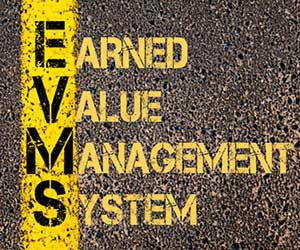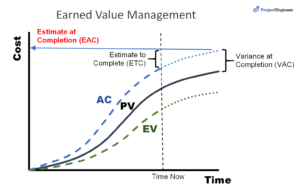
In earned value analysis, the Estimate at Completion (EAC) is your forecast of the final project price tag, built on how the project has performed so far.
More than just a number, it gives project managers a critical glimpse into what the total cost will likely be when the dust settles.
The Bigger Picture
The EAC is one of four calculations in the Earned Value Management which allow you to forecast the future performance of the project.
- Estimate to Complete (ETC)
- Estimate at Completion (EAC)
- Variance at Completion (VAC)
- To Complete Performance Index (TCPI)
How to Calculate EAC
Because EAC is a predictive metric, there are four ways to calculate EAC based on how you expect the future of the performance of the project to be:
 Future performance will be based on the budgeted cost
Future performance will be based on the budgeted cost
If you think the existing variance was a unique event and the rest of the project is likely go according to plan, simply add the remaining project budget to the actual cost incurred to date (AC). This method does not assume the project finishes on budget. Rather it takes into account the one time event and adjusts the remaining project plan upward or downward accordingly.EAC = AC + (BAC – EV)- Future cost performance will be based on past cost performance
If you think the past performance is not unusual and the past performance is a good indicator of the future, you would use this formula.EAC = AC + [(BAC – EV) / CPI] - Future cost performance will be influenced by past schedule performance
Since schedule and cost performance are usually related, there could be a reason to adjust the cost performance based on the schedule performance. For example let’s say the CPI (cost efficiency) is very low but SPI (schedule efficiency) is high, you would be justified in thinking that the final cost performance won’t likely be as bad as the CPI would suggest. In the following formula an average of the CPI and SPI are used to extrapolate the final project cost.EAC = AC + [(BAC -EV) / (CPI x SPI)]You could also use a combination of the SPI and CPI instead of a straight average. In the formula below, 20% of the SPI and 80% of the CPI has been used to determine the final project cost.
EAC = AC + [(BAC – EV) / (0.8·CPI x 0.2·SPI)] - The Budget and Schedule are no longer valid
When a major variance has occured, a new ETC can be added to the to-date cost (AC) to determine the final EAC.EAC = AC + ETC
The first two forecasting methods represent the high and low extremes, and the third represents an attempt to forecast somewhere in between those extremes. Finally, the fourth method represents a new estimate, a brand new value taken from other sources if none of the other methods are able to produce the desired result.
For example, if the project is currently over budget, the worst case scenario would have you forecasting using the current trajectory. The best case scenario would have you using the original planned trajectory, starting from today’s date. If you feel you need to be somewhere in between, you can use a combination of the past schedule and cost performance (SPI and CPI), and if none of those alternatives give you the desired result, you will need to produce a new estimate.
EAC Example
In this example we will predict that the current problems were caused by a one time event that isn’t likely to repeat itself. Thus, the EAC will use formula #1.
EAC = AC + (BAC – EV)
EAC = $4,000 + ($10,000 – $2,000) = $12,000.
| ID | Name | Start | End | BAC | PV | EV | AC | SV | SPI | CV | CPI | ETC | EAC |
|---|---|---|---|---|---|---|---|---|---|---|---|---|---|
| 100 | Write Report | June 1 | June 10 | $10,000 | $2.500 | $2,000 | $4,000 | -$500 | 0.80 | -$2,000 | 0.50 | $16,000 | $12,000 |
One can quickly see that the task, which was supposed to cost $10,000 (BAC) will now cost $12,000 (EAC).
To learn more about earned value management, please see our Earned Value Tutorial.











 Jax de Beer says
Jax de Beer says
June 19, 2018 at 1:25 amHi there!
In which scenario would you use the formula AC/% complete to calculate EAC?
 Eric says
Eric says
August 5, 2019 at 2:55 pmAC/% complete is equivalent to method #2 above.